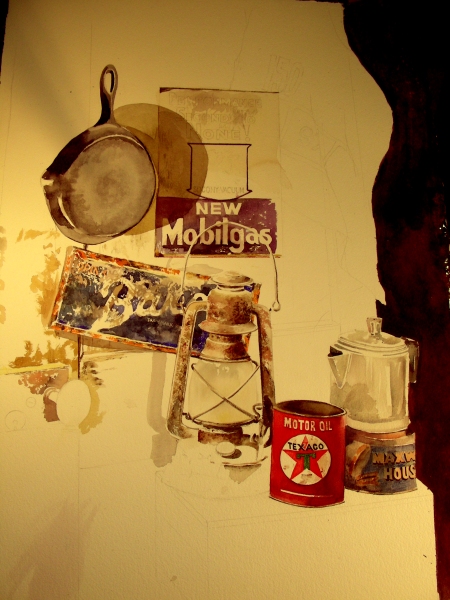Ernest Hemingway could not write about Michigan until he was in Paris, and could not write about Paris until he had returned to the United States. On this first day of the New Year, I am returning to my ninth grade in House Springs Missouri, at Northwest High School. In Proustlike fashion, this still life with the kerosene lantern is transporting me back to my Art I class, period 1, when we walked into class and saw a collection of at least fifteen objects assembled in the middle of the classroom, and the table arranged in a circle about the perimeter. Each of us was given a full-size sheet of newsprint paper (perhaps 18 x 24″), a charcoal pencil, a blending stump and a kneaded eraser.
Immediately, a girl protested: “Mr. Scucchi, I cannot fit all that on this paper!” Coolly, the teacher replied: “Did you ever draw a house?” Discussion over. Time to draw.
At college there was an ancient Greek vase on the table in the seminar room where our class in Greek was held. Fresh from Michigan, I had never seen anything before with lines so simple and yet so beautiful, and I marveled at it day after day. In those hours of a student’s trancelike wonder there was born the resolve, unconscious at first, to go to Greece.
The Art I students would sit before this giant still life for three weeks, fifteen instructional periods. And in those periods, I became lost in wonder at the kerosene lantern, the focal point (for me) to this immense pile of objects that included a jug, a Ruffino wine bottle with straw bottom, corn scoop, football helmet, antique water pump, bricks and drapery.
With charcoal pencil and blending stump, I became absorbed with the textures of the kerosene lantern, the complications of a smoky globe with highlights and scratches and thin wires wound about it, the rusted and pitted armature catching highlights and absorbing shadows, the thinness of the bail that arced above the lantern, and the issues of rendering this delicate piece of iron with charcoal as it presented itself as a string of highlights, mid-tones and shadows. I realize now that, as a ninth-grader, I was not as dull as I and my peers had regarded me. It is a certainty that I was not academically astute or interested, but during those days I realized that I was visually alert and interested in these objects.
No Ideas but in Things.

